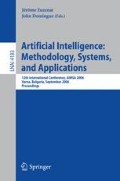Abstract
We present a novel, simple, unsupervised method for characterizing the semantic relations that hold between nouns in noun-noun compounds. The main idea is to discover predicates that make explicit the hidden relations between the nouns. This is accomplished by writing Web search engine queries that restate the noun compound as a relative clause containing a wildcard character to be filled in with a verb. A comparison to results from the literature suggest this is a promising approach.
Access this chapter
Tax calculation will be finalised at checkout
Purchases are for personal use only
Preview
Unable to display preview. Download preview PDF.
References
Lapata, M., Keller, F.: Web-based models for natural language processing. ACM Transactions on Speech and Language Processing 2, 1–31 (2005)
Banko, M., Brill, E.: Scaling to very very large corpora for natural language disambiguation. In: Proceedings of the 39th Annual Meeting on Association for Computational Linguistics, pp. 26–33 (2001)
Nakov, P., Hearst, M.: Search engine statistics beyond the n-gram: Application to noun compound bracketing. In: Proceedings of the 9th Conference on Computational Natural Language Learning, pp. 17–24 (2005)
Nakov, P., Hearst, M.: Using the Web as an implicit training set: Application to structural ambiguity resolution. In: Proceedings of HLT-EMNLP, Vancouver, British Columbia, Canada, pp. 835–842 (2005)
Downing, P.: On the creation and use of English compound nouns. Language 53(4), 810–842 (1977)
Levi, J.: The Syntax and Semantics of Complex Nominals. Academic Press, New York (1978)
Lauer, M.: Designing Statistical Language Learners: Experiments on Noun Compounds. PhD thesis, Department of Computing Macquarie University NSW 2109 Australia (1995)
Rosario, B., Hearst, M.: Classifying the semantic relations in noun compounds via a domain-specific lexical hierarchy. In: Lee, L., Harman, D. (eds.) Proceedings of EMNLP (Empirical Methods in Natural Language Processing), pp. 82–90 (2001)
Rosario, B., Hearst, M., Fillmore, C.: The descent of hierarchy, and selection in relational semantics. In: Proceedings of ACL, pp. 247–254 (2002)
Girju, R., Moldovan, D., Tatu, M., Antohe, D.: On the semantics of noun compounds. Computer Speech and Language 19(4), 479–496 (2005)
Lapata, M.: The disambiguation of nominalisations. Computational Linguistics 28(3), 357–388 (2002)
Girju, R., Giuglea, A.M., Olteanu, M., Fortu, O., Bolohan, O., Moldovan, D.: Support vector machines applied to the classification of semantic relations in nominalized noun phrases. In: Proceedings of the HLT-NAACL Workshop on Computational Lexical Semantics, Boston, MA, pp. 68–75 (2004)
Moldovan, D., Badulescu, A., Tatu, M., Antohe, D., Girju, R.: Models for the semantic classification of noun phrases. In: Proceedings of the Computational Lexical Semantics Workshop at HLT-NAACL, pp. 60–67 (2004)
Turney, P., Littman, M.: Corpus-based learning of analogies and semantic relations. Machine Learning Journal 60(1-3), 251–278 (2005)
Turney, P.: Expressing implicit semantic relations without supervision. In: Proceedings of COLING-ACL, Australia (2006)
Finin, T.: The Semantic Interpretation of Compound Nominals. Ph.D. dissertation, University of Illinois, Urbana, Illinois (1980)
Vanderwende, L.: Algorithm for automatic interpretation of noun sequences. In: Proceedings of COLING 1994, pp. 782–788 (1994)
Barker, K., Szpakowicz, S.: Semi-automatic recognition of noun modifier relationships. In: Proceedings of COLING-ACL 1998, Montreal, Canada, pp. 96–102 (1998)
Fellbaum, C. (ed.): WordNet: An Electronic Lexical Database. MIT Press, Cambridge (1998)
Toutanova, K., Klein, D., Manning, C., Singer, Y.: Feature-rich part-of-speech tagging with a cyclic dependency network. In: Proceedings of HLT-NAACL 2003, pp. 252–259 (2003)
Lin, D., Pantel, P.: Discovery of inference rules for question-answering. Natural Language Engineering 7(4), 343–360 (2001)
Shinyama, Y., Sekine, S., Sudo, K., Grishman, R.: Automatic paraphrase acquisition from news articles. In: Proceedings of Human Language Technology Conference (HLT 2002), San Diego, USA, pp. 40–46 (2002)
Baldwin, T., Tanaka, T.: Translation by machine of complex nominals: Getting it right. In: Proceedings of the ACL 2004 Workshop on Multiword Expressions: Integrating Processing, pp. 24–31 (2004)
Callison-Burch, C., Koehn, P., Osborne, M.: Improved statistical machine translation using paraphrases. In: Proceedings of HLT-NAACL 2006, pp. 17–24 (2006)
Russo-Lassner, G., Lin, J., Resnik, P.: A paraphrase-based approach to machine translation evaluation. Technical Report LAMP-TR-125/CS-TR-4754/UMIACS-TR-2005-57, University of Maryland (2005)
Kauchak, D., Barzilay, R.: Paraphrasing for automatic evaluation. In: Proceedings of HLT-NAACL 2006, pp. 455–462 (2006)
Zhou, L., Lin, C.-Y., Munteanu, D.S., Hovy, E.: PARAEVAL: Using paraphrases to evaluate summaries automatically. In: Proceedings of HLT-NAACL 2006, pp. 447–454 (2006)
Tatu, M., Moldovan, D.: A semantic approach to recognizing textual entailment. In: Proceedings of HLT/EMNLP 2005, pp. 371–378 (2005)
Zhai, C.: Fast statistical parsing of noun phrases for document indexing. In: Proceedings of the Fifth Conference on Applied Natural Language Processing, pp. 312–319. Morgan Kaufmann Publishers Inc., San Francisco (1997)
Etzioni, O., Cafarella, M., Downey, D., Popescu, A.-M., Shaked, T., Soderland, S., Weld, D.S., Yates, A.: Unsupervised named-entity extraction from the web: an experimental study. Artificial Intelligence 165(1), 91–134 (2005)
Katz, J., Fodor, J.: The structure of a semantic theory. Language (39), 170–210 (1963)
Jackendoff, R.: Semantics and Cognition. MIT Press, Cambridge (1983)
Saeed, J.: Semantics, 2nd edn. Blackwell, Malden (2003)
Author information
Authors and Affiliations
Editor information
Editors and Affiliations
Rights and permissions
Copyright information
© 2006 Springer-Verlag Berlin Heidelberg
About this paper
Cite this paper
Nakov, P., Hearst, M. (2006). Using Verbs to Characterize Noun-Noun Relations. In: Euzenat, J., Domingue, J. (eds) Artificial Intelligence: Methodology, Systems, and Applications. AIMSA 2006. Lecture Notes in Computer Science(), vol 4183. Springer, Berlin, Heidelberg. https://doi.org/10.1007/11861461_25
Download citation
DOI: https://doi.org/10.1007/11861461_25
Publisher Name: Springer, Berlin, Heidelberg
Print ISBN: 978-3-540-40930-4
Online ISBN: 978-3-540-40931-1
eBook Packages: Computer ScienceComputer Science (R0)

